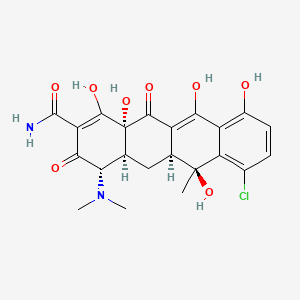| MeSH term | MeSH ID | Detail |
|---|---|---|
| Myocardial Infarction | D009203 | 21 associated lipids |
| Diarrhea | D003967 | 32 associated lipids |
| Uremia | D014511 | 33 associated lipids |
| Anemia, Sickle Cell | D000755 | 34 associated lipids |
| Leukemia, Experimental | D007942 | 42 associated lipids |
| Weight Gain | D015430 | 101 associated lipids |
| Inflammation | D007249 | 119 associated lipids |
| Adenocarcinoma | D000230 | 166 associated lipids |
| Body Weight | D001835 | 333 associated lipids |
chlortetracycline
chlortetracycline is a lipid of Polyketides (PK) class. Chlortetracycline is associated with abnormalities such as Granulomatous Disease, Chronic, Infection, Ischemia, Cerebral Ischemia and Cerebral Infarction. The involved functions are known as Regulation, Binding (Molecular Function), Agent, Stimulus and Process. Chlortetracycline often locates in Protoplasm, Plasma membrane, Membrane, Cytoplasm and specific granule. The associated genes with chlortetracycline are FPR1 gene, P4HTM gene, Homologous Gene, HIST1H1C gene and Microbiome. The related lipids are Lysophosphatidylcholines, Sterols, dilauroyl lecithin, seminolipid and Total cholesterol. The related experimental models are Mouse Model.
Cross Reference
Introduction
To understand associated biological information of chlortetracycline, we collected biological information of abnormalities, associated pathways, cellular/molecular locations, biological functions, related genes/proteins, lipids and common seen animal/experimental models with organized paragraphs from literatures.
What diseases are associated with chlortetracycline?
chlortetracycline is suspected in Ischemia, Cerebral Ischemia, Cerebral Infarction, Granulomatous Disease, Chronic, Infection, Antibiotic resistant infection and other diseases in descending order of the highest number of associated sentences.
Related references are mostly published in these journals:
| Disease | Cross reference | Weighted score | Related literature |
|---|
Possible diseases from mapped MeSH terms on references
We collected disease MeSH terms mapped to the references associated with chlortetracycline
PubChem Associated disorders and diseases
What pathways are associated with chlortetracycline
There are no associated biomedical information in the current reference collection.
PubChem Biomolecular Interactions and Pathways
Link to PubChem Biomolecular Interactions and PathwaysWhat cellular locations are associated with chlortetracycline?
Visualization in cellular structure
Associated locations are in red color. Not associated locations are in black.
Related references are published most in these journals:
| Location | Cross reference | Weighted score | Related literatures |
|---|
What functions are associated with chlortetracycline?
Related references are published most in these journals:
| Function | Cross reference | Weighted score | Related literatures |
|---|
What lipids are associated with chlortetracycline?
Related references are published most in these journals:
| Lipid concept | Cross reference | Weighted score | Related literatures |
|---|
What genes are associated with chlortetracycline?
Related references are published most in these journals:
| Gene | Cross reference | Weighted score | Related literatures |
|---|
What common seen animal models are associated with chlortetracycline?
Mouse Model
Mouse Model are used in the study 'Chlortetracycline and demeclocycline inhibit calpains and protect mouse neurons against glutamate toxicity and cerebral ischemia.' (Jiang SX et al., 2005).
Related references are published most in these journals:
| Model | Cross reference | Weighted score | Related literatures |
|---|
NCBI Entrez Crosslinks
All references with chlortetracycline
Download all related citations| Authors | Title | Published | Journal | PubMed Link |
|---|---|---|---|---|
| Smolen JE et al. | The fluorescence response of chlorotetracycline-loaded human neutrophils. Correlations with lysosomal enzyme release and evidence for a 'trigger pool' of calcium. | 1982 | Biochim. Biophys. Acta | pmid:7126637 |
| Riquelme G et al. | Lipid monolayer expansion by calcium-chlorotetracycline at the air/water interface and, as inferred from cell shape changes, in the human erythrocyte membrane. | 1982 | Biochim. Biophys. Acta | pmid:7115708 |
| Runsey TS et al. | Residue content of beef feedlot manure after feeding diethylstilbestrol, chlortetracycline and Ronnel and the use of stirofos to reduce population of fly larvae in feedlot manure. | 1977 | Arch. Environ. Contam. Toxicol. | pmid:71021 |
| Skakun NP and VysotskiÄ IIu | [Effect of tetracyclines on bile formation in the liver]. | 1982 | Antibiotiki | pmid:7092192 |
| Yokoyama MT et al. | The effects of antibiotics in the weanling pig diet on growth and the excretion of volatile phenolic and aromatic bacterial metabolites. | 1982 | Am. J. Clin. Nutr. | pmid:7081123 |
| Moulder JW et al. | Association between resistance to superinfection and patterns of surface protein labeling in mouse fibroblasts (L cells) persistently infected with Chlamydia psittaci. | 1982 | Infect. Immun. | pmid:7068218 |
| Mathew MK et al. | Ionophore-mediated transmembrane movement of divalent cations in small unilamellar liposomes: an evaluation of the chlortetracycline fluorescence technique and correlations with black lipid membrane studies. | 1982 | J. Membr. Biol. | pmid:7057457 |
| Plakunov VK et al. | Effect of monovalent cations on assimilation of tetracycline antibiotics by bacteria. | 1980 Nov-Dec | Biol Bull Acad Sci USSR | pmid:7037061 |
| Lüthgen W and Traub C | [Prophylaxis and therapy of psittacosis in the canary-winged parakeet (Brotogeris versicolorus chiriri (author's transl)]. | 1981 | DTW. Dtsch. Tierarztl. Wochenschr. | pmid:7030692 |
| Darougar S et al. | A double-blind comparison of topical therapy of chlamydial ocular infection (TRIC infection) with rifampicin or chlortetracycline. | 1981 | Br J Ophthalmol | pmid:7028084 |
